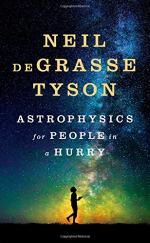|
This section contains 1,149 words (approx. 3 pages at 400 words per page) |

|
Summary
Straying slightly from astrophysics in favor of chemistry, Tyson begins this chapter by stressing the interrelated nature of the two fields, claiming knowledge of the “origin and evolution of the universe” is crucial to understanding how the Periodic Table of Elements came to be (115). While the elements are usually forgotten after high-school chemistry, Tyson claims the Table “instead ought to be a cultural icon, a testimony to the enterprise of science as an international human adventure” (116). He begins his investigation into the Periodic Table with the three elements naturally formed in the big bang, hydrogen, helium, and lithium. Hydrogen, “the lightest and simplest element” makes up “more than two-thirds of all the atoms in the human body, and more than ninety percent of all atoms in the cosmos,” making it the by-far the most abundant element. Helium, its close relative...
(read more from the The Cosmos on the Table Summary)
|
This section contains 1,149 words (approx. 3 pages at 400 words per page) |

|




